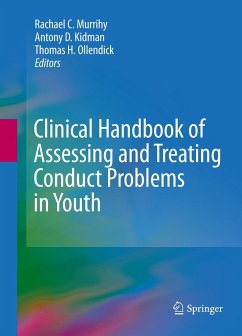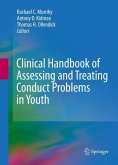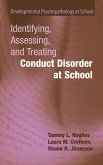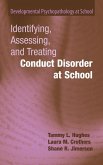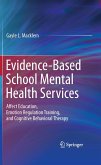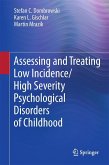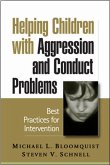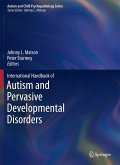Conduct problems, particularly oppositional defiant disorder (ODD) and conduct disorder (CD), are the most common mental health problems affecting children and adolescents. The consequences to individuals, families, and schools may be severe and long-lasting. To ameliorate negative outcomes and ensure the most effective treatment for aggressive and antisocial youth, early diagnosis and evidence-based interventions are essential.
Clinical Handbook of Assessing and Treating Conduct Problems in Youth provides readers with both a solid grounding in theory and a comprehensive examination of the evidence-based assessment strategies and therapeutic practices that can be used to treat a highly diverse population with a wide range of conduct problems. It provides professional readers with an array of evidence-based interventions, both universal and targeted, that can be implemented to improve behavioral and social outcomes in children and adolescents.
This expertly written resource:
Lays the foundation for understanding conduct problems in youth, including epidemiology, etiology, and biological, familial, and contextual risk factors.Details the assessment process, with in-depth attention to tools, strategies, and differential diagnosis.Reviews nine major treatment protocols, including Parent-Child Interaction Therapy (PCIT), multisystemic therapy (MST) for adolescents, school-based group approaches, residential treatment, and pharmacotherapy.Critiques the current generation of prevention programs for at-risk youth.Explores salient issues in working effectively with minority youth.Offers methods for evaluating intervention programs, starting with cost analysis.
This volume serves as a one-stop reference for all professionals who seek a solid grounding in theory as well as those who need access to evidence-based assessment and therapies for conduct problems. It is a must-have volumefor anyone working with at-risk children, including clinical child, school, and developmental psychologists; forensic psychologists; social workers; school counselors and allied professionals; and medical and psychiatric practitioners.
Clinical Handbook of Assessing and Treating Conduct Problems in Youth provides readers with both a solid grounding in theory and a comprehensive examination of the evidence-based assessment strategies and therapeutic practices that can be used to treat a highly diverse population with a wide range of conduct problems. It provides professional readers with an array of evidence-based interventions, both universal and targeted, that can be implemented to improve behavioral and social outcomes in children and adolescents.
This expertly written resource:
Lays the foundation for understanding conduct problems in youth, including epidemiology, etiology, and biological, familial, and contextual risk factors.Details the assessment process, with in-depth attention to tools, strategies, and differential diagnosis.Reviews nine major treatment protocols, including Parent-Child Interaction Therapy (PCIT), multisystemic therapy (MST) for adolescents, school-based group approaches, residential treatment, and pharmacotherapy.Critiques the current generation of prevention programs for at-risk youth.Explores salient issues in working effectively with minority youth.Offers methods for evaluating intervention programs, starting with cost analysis.
This volume serves as a one-stop reference for all professionals who seek a solid grounding in theory as well as those who need access to evidence-based assessment and therapies for conduct problems. It is a must-have volumefor anyone working with at-risk children, including clinical child, school, and developmental psychologists; forensic psychologists; social workers; school counselors and allied professionals; and medical and psychiatric practitioners.
"Overall, the combination of the traditional subjects, updated and enriched by clinically vivid portraits of the topics, with a healthy infusion of fresh, innovative material, makes this book for now the preferred reference on this topic for practicing clinical psychologists." -- Joseph C. Blader PsycCRITIQUES, July 6, 2011, Vol. 56, Release 27, Article 9
From the reviews:
"Overall, the combination of the traditional subjects, updated and enriched by clinically vivid portraits of the topics, with a healthy infusion of fresh, innovative material, makes this book for now the preferred reference on this topic for practicing clinical psychologists."
Joseph C. Blader
PsycCRITIQUES, July 6, 2011, Vol. 56, Release 27, Article 9
"This book provides a comprehensive overview of what is currently known about child and adolescent behaviour problems. ... it's an easy-to-read resource for both researchers and clinicians who wish to develop a solid theoretical understanding of these problems. It also details practical, evidence-based assessment and intervention options that can be applied across a range of settings and is tailored to meet individual needs, such as parent management strategies, family therapy and cognitive behaviour therapy." (Danielle Ellis, UTS News Room, November, 2012)
"Overall, the combination of the traditional subjects, updated and enriched by clinically vivid portraits of the topics, with a healthy infusion of fresh, innovative material, makes this book for now the preferred reference on this topic for practicing clinical psychologists."
Joseph C. Blader
PsycCRITIQUES, July 6, 2011, Vol. 56, Release 27, Article 9
"This book provides a comprehensive overview of what is currently known about child and adolescent behaviour problems. ... it's an easy-to-read resource for both researchers and clinicians who wish to develop a solid theoretical understanding of these problems. It also details practical, evidence-based assessment and intervention options that can be applied across a range of settings and is tailored to meet individual needs, such as parent management strategies, family therapy and cognitive behaviour therapy." (Danielle Ellis, UTS News Room, November, 2012)

